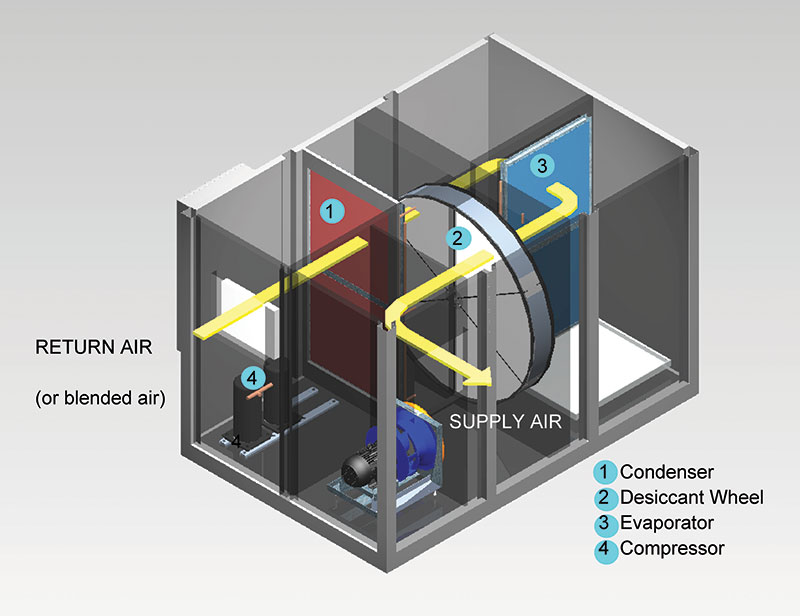Recirculating Dehumidifiers
Recirculating (return air) DES/DX units are highly efficient dehumidifiers that combine the benefits of both desiccant dehumidification and DX cooling. The condenser waste heat from the refrigeration cycle is captured and used to regenerate the desiccant wheel in order to achieve further dehumidification.
This combination of DX cooling with a desiccant rotor avoids overcooling and eliminates the need for reheat. Consequently, operating cost savings of up to 40% can be realized when compared to the traditional method of DX overcooling followed by reheat.
- Standard models available in the range of 300-10000 cfm
- Provides “real” independent humidity control
- Saves energy by maintaining comfort at higher set point temperatures
- Prevents mold, mildew, and dust mite growth by maintaining relative humidity below 50%
- Dehumidifies without raising the supply temperature.
How it Works
Inlet air is first cooled and dehumidified as it passes through the evaporator coil. The cool saturated air then passes through NovelAire’s proprietary desiccant rotor, where the air is further dehumidified. The air heats up as the moisture is removed, providing a supply air that is close to the inlet air temperature. Waste condenser heat is used to regenerate the desiccant rotor. By utilizing this waste heat, the unit becomes an extremely efficient dehumidifier.
Application
The DES/DX unit is particularly suited to provide independent humidity control for restaurants, theaters, hospitals, hotels, and supermarkets. The DES/DX unit is able to maintain indoor air conditions in a dry and cool comfort zone suitable to the patrons of the establishment while avoiding the “cold and clammy” feel associated with traditional humidity control via overcooling with DX equipment. In fact, during many hours of the day, the sensible load is insufficient to call for DX cooling; therefore, humidity control is nonexistent during this period of time. Not so with the DES/DX unit.
Since it is controlled from a separate humidistat, the unit will continue to operate without overcooling as it relies on its desiccant rotor to provide dehumidification and energy free reheat. The advantage of the DES/DX unit is particularly evident during the ‘shoulder’ months in the spring and fall, when mild sensible temperatures do not require typical DX cooling yet the relative humidity can still be quite high.
Under this scenario, the DES/DX will continue to operate and control the indoor humidity efficiently and effectively without relying on overcooling. Patron and employee comfort is easily maintained in the typical 50% RH range.
